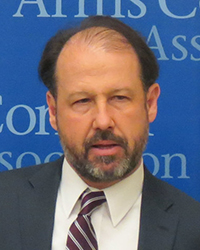By Daryl G. Kimball
The writer is the Executive Director of the Arms Control Association (ACA). The following article appears as the Focus of the June 2024 issue of Arms Control Today.
WASHINGTON, D.C. | 6 Jun 2024 (IDN) — Since Russian President Vladimir Putin launched his full-scale, illegal, and brutal assault on Ukraine in early 2022, he has issued occasional threats of nuclear weapons use against anyone who might interfere. The result is a heightened risk of nuclear war between Russia and NATO in ways not seen in the post-Cold War era.

After strong international criticism of his nuclear rhetoric in the weeks and months following the invasion, Putin dialed back his threats in 2023. But last month, he publicly authorized field exercises designed to demonstrate the potential use of substrategic nuclear weapons by Russia against NATO or Ukraine. The drills were held in Russia’s Southern Military District, which includes Russian areas adjoining Ukraine and Ukrainian territory seized by Moscow.
If nuclear weapons are used in this or any conflict between nuclear-armed adversaries, there is no guarantee that the fighting would not quickly become an all-out nuclear conflagration. As U.S. President Joe Biden warned in 2022, “I don’t think there’s any such thing as an ability to easily use a tactical nuclear weapon and not end up with Armageddon.” The Group of 20 nations also underscored the dangers in joint statements in 2022 and 2023, saying the use of nuclear weapons and threats of use are “inadmissible.”
Putin’s cronies claim that Russia’s substrategic nuclear drills are a response to statements by French President Emmanuel Macron that NATO should not rule out sending ground forces into Ukraine and by UK Foreign Minister David Cameron that Western-supplied weapons could be used by Ukraine to strike targets in Russia.
The instinct of European leaders to do more to help Ukraine is laudable, and renewed Russian attempts to use nuclear coercion to block such assistance are unsurprising, but both risk escalation that could lead to a wider European war and potential nuclear catastrophe.
Calibrate carefully and coordinate military support to avoid escalation
Given the stakes, the international community must pursue approaches that lower tensions, increase dialogue, and resist those who threaten to break the nuclear taboo.
As U.S. and European leaders continue to supply Ukraine with the weapons it needs to repel Russia, they must calibrate carefully and coordinate their military support to avoid escalation. So far, the Biden administration has designed its military aid packages wisely and delivered increasingly advanced weapons to help Ukraine defend itself in a way that does not trigger Russian attacks on U.S. or NATO forces or territory.
U.S. and NATO leaders must continue to refrain from making rhetorical threats of nuclear retaliation, avoid provocative nuclear exercises, and rule-out mirroring counterproductive Russian moves, such as the forward deployment of Russian substrategic nuclear weapons in Belarus.
The United States could help reinforce legally binding negative security assurances for many non-nuclear-weapon states against nuclear attack by finally ratifying the protocols to three nuclear-weapon-free-zone treaties covering the South Pacific, Africa, and Central Asia that have languished in the Senate for more than a decade. Working through the Conference on Disarmament, the United States also could join with China to start negotiations on a global treaty to provide negative nuclear security assurances to all non-nuclear-weapon states.
Non-nuclear majority needs to push back harder against nuclear threats
As importantly, the world’s non-nuclear majority needs to push back harder against nuclear threats by Russia or any other state. In 2022, states-parties to the Treaty on the Prohibition of Nuclear Weapons issued an important statement noting that “any use or threat of use of nuclear weapons is a violation of international law.” They also condemned “unequivocally any and all nuclear threats, whether they be explicit or implicit and irrespective of the circumstances.” Russia was not named in the statement, but the message was clear.
One joint statement is not enough. Whenever any nuclear-armed state attempts to engage in nuclear coercion, as Russia is doing, it is in the self-interest of all states to condemn such threats and demand that offenders refrain from provocative actions.
Resuming the suspended Russian-U.S. dialogue on nuclear risk reduction and arms control is crucial to avoiding nuclear miscalculation and competition. Non-nuclear-weapon states could help by urging Moscow and Washington to meet their nuclear Nonproliferation Treaty (NPT) Article VI disarmament commitments by engaging in talks on a new nuclear arms control framework agreement before the New Strategic Arms Reduction Treaty expires in 2026.
All states concerned about nuclear escalation also could urge the five NPT nuclear-weapon states to express support for the 1973 Soviet-U.S. Agreement on the Prevention of Nuclear War, which requires that states refrain from nuclear threats and, in times of increased risk of nuclear conflict, “immediately enter into urgent consultations with each other and make every effort to avert this risk.”
So far, the 79-year-old taboo against the use of nuclear weapons has held, but the world cannot take it for granted. Tragically, the end of Russia’s war on Ukraine is nowhere in sight. To preserve and strengthen the consensus against nuclear weapons use and threats of use, we must sustain pressure against those who might try to break the nuclear taboo. [IDN-InDepthNews]
Photo: Iskander-M live fire test. Credit: Russia MoD


